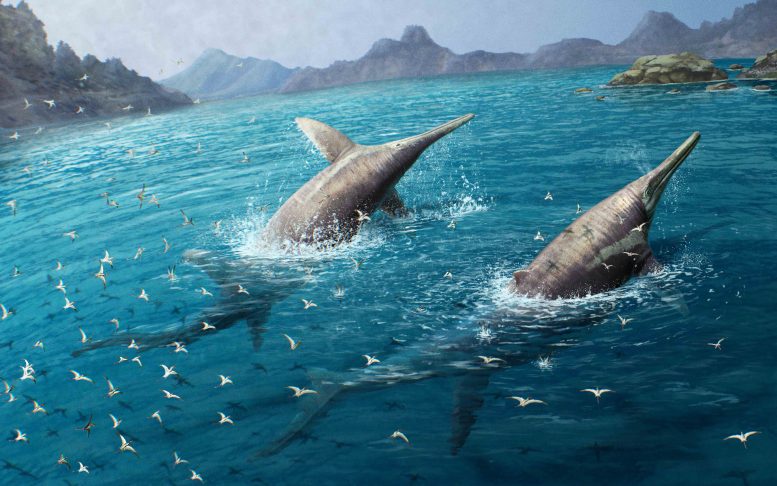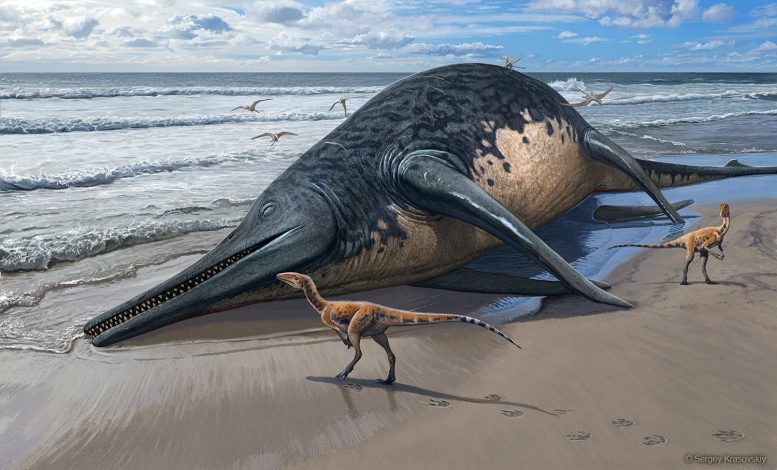
A new species of ichthyosaur, possibly the largest marine reptile ever, has been discovered in the UK. Named Ichthyotitan severnensis, it could have measured up to 25 meters in length, based on jawbone fragments found in Somerset. Further discoveries could provide more insights into these ancient giants. A giant pair of swimming Ichthyotitan severnensis. Credit: Gabriel Ugueto, CC-BY 4.0
The enormous ichthyosaur could have reached lengths exceeding 80 feet (25 meters) and existed during the Late Triassic period.
A recently identified ichthyosaur species may be the largest marine reptile ever recorded, suggests a study recently published in the open-access journal PLOS ONE. The research, conducted by Dean R. Lomax and his team from the University of Bristol and the University of Manchester, UK, adds significant insights into the dimensions of prehistoric marine life.
Over the past few years, Lomax and his research team discovered and pieced together individual fragments of an ichthyosaur jawbone from the Westbury Mudstone Formation in Somerset, UK. The new bone was similar in size and shape to another jawbone collected from the same rock formation just a few miles away — and the researchers now believe these two jawbones belong to a previously undescribed species of ichthyosaur, a group of massive, ocean-dwelling reptiles from the age of the dinosaurs.
The Size of Ichthyotitan severnensis
Based on the length of these bones, the new species, named Ichthyotitan severnensis, may have been a whopping 25 meters (82 feet) long, or twice the length of a city bus. However, since the new species is being described solely via limited bone fragments, the study authors stress that further paleontological evidence is needed to confirm just how large I. severnensis likely was.

A washed-up Ichthyotitan severnensis carcass on the beach. Credit: Sergey Krasovskiy, CC-BY 4.0
Ichthyosaurs, many of which looked like modern-day dolphins, first evolved during the early Triassic period around 250 million years ago. Within a few million years, some ichthyosaurs had evolved to reach at least 15 meters (49 feet) long, and by the Late Triassic (roughly 200 million years ago), the largest ichthyosaurs had evolved, including the newly described I. severnensis. This reign didn’t necessarily last long, however. While some species of ichthyosaur continued to roam the oceans for millions of years, these “giant ichthyosaurs” are believed to have gone extinct during the Triassic-Jurassic extinction event 200 million years ago — and this unique group of marine reptiles never again reached such a gargantuan size.
Dr. Dean Lomax adds: “In 2018, my team (including Paul de la Salle) studied and described Paul’s giant jawbone and we had hoped that one day another would come to light. This new specimen is more complete, better preserved, and shows that we now have two of these giant bones (called a surangular) that have a unique shape and structure. It is quite remarkable to think that gigantic, blue whale-sized ichthyosaurs were swimming in the oceans around what was the UK during the Triassic Period. These jawbones provide tantalizing evidence that perhaps one day a complete skull or skeleton of one of these giants might be found. You never know.”
Reference: “The last giants: New evidence for giant Late Triassic (Rhaetian) ichthyosaurs from the UK” by Dean R. Lomax, Paul de la Salle, Marcello Perillo, Justin Reynolds, Ruby Reynolds and James F. Waldron, 17 April 2024, PLOS ONE.
DOI: 10.1371/journal.pone.0300289
>>> Read full article>>>
Copyright for syndicated content belongs to the linked Source : SciTechDaily – https://scitechdaily.com/more-than-80-feet-long-newly-discovered-ichthyosaur-may-be-the-largest-marine-reptile-ever/































